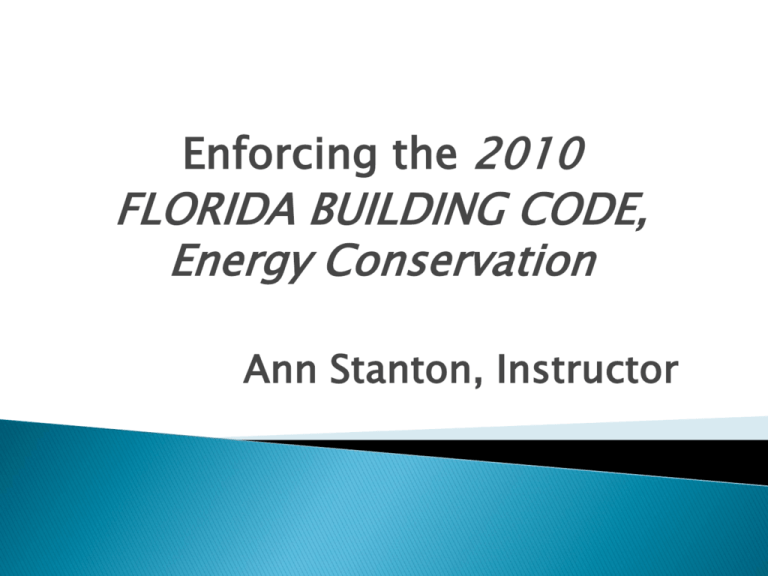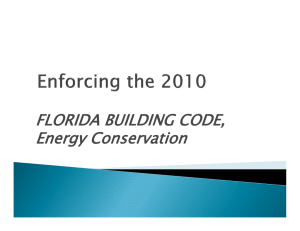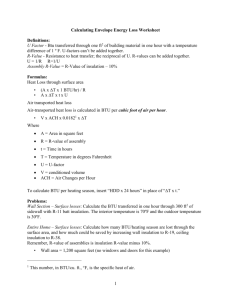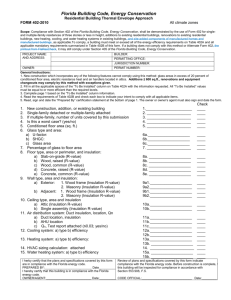Code Administration - Florida Building Code
advertisement

Enforcing the 2010 FLORIDA BUILDING CODE, Energy Conservation Ann Stanton, Instructor Although Florida’s energy code has been in effect statewide since 1979, it is now based on the International Energy Conservation Code (IECC). It is a minimum standard for energy use in buildings It applies to all new buildings and additions that are heated or cooled for human comfort. It applies to “renovations” for the items being changed. It applies to “building systems” in existing buildings: HVAC, water heating, lighting, motors Existing buildings ◦ except certain renovations, additions, changes of occupancy type & new building systems that have to comply. Buildings where the design rate is less than 1Watt/square foot Buildings not heated or cooled by mechanical means Buildings not conditioned for human comfort where no-one works on a regular basis. Buildings where federal standards preempt state codes Hunting or recreational buildings less than 1,000 square feet that are not a principal residence. A Prescriptive compliance method, where you do everything on a list of prescribed requirements; or A Performance compliance method, where the building complies as a whole by means of an energy simulation analysis tool where the performance of the building as designed is compared to its performance when calculated with Standard Reference Design features (effectively, the building must come in under an energy budget). There are few minimum code requirements in a performance-based code. CHAPTER 4 RESIDENTIAL ENERGY EFFICIENCY Administration Building envelope Form 402: Prescriptive compliance Walls, ceilings floors: Meet minimum R-values given in Table 402.1.1 Frame walls R-13 Block walls Interior insulation R-7.8 Exterior insulation R-6 Ceilings: R-30 Floors: Raised R-13, SOG R-0 Form 405: Performance compliance Walls, ceilings, floors: No minimums except R-19 ceiling, space permitting (State law) Windows: Maximum 20% of conditioned floor area; U-factor ≤0.65; SHGC ≤0.30 Windows: No limit. Maximum weighted average SHGC 0.50 except if 4’ overhang Ducts: Must be inside conditioned space & tested to Qn ≤0.03 by a Class 1 BERS Rater or Class A, B or Mechanical contractor Ducts: R-6 if in the attic. Credit provided if testing shows less leakage HVAC Controls: Programmable thermostat required for forced air furnaces HVAC Controls: Thermostat required for each system. Credit for programmable thermostat. Form 402-2010 is a 2 page list of prescriptive requirements and features that will be installed. There is now another Prescriptive code compliance alternative for residential applications—the Total UA Alternative It allows U-value tradeoffs for the building walls, windows, ceiling and floors. It tells you whether the building envelope meets code. You’ll need to read the printout carefully to find out if they say they met all other criteria for compliance by Section 402 (ducts in conditioned space, tested to “significantly leak-free”; maximum 20% glass to floor area; maximum SHGC 0.30; no electric resistance heat, etc.). Two Total UA Alternative programs have been approved by the Commission: ◦ a US Department of Energy program called REScheck that doesn’t look at all like other Florida forms. ◦ EnergyGauge USA has a Total UA envelope calculation in it as well Form 405 is a printout from a Commissionapproved computer program Go to http://www.floridabuilding.org/fbc/committees/ energy/Energy_Code_Compliance_Software.html for a list of Commission-approved energy code compliance software. Single-family home (including duplexes and town homes) calculation can be performed by anyone. Multiple-family homes calculations can be performed by an architect, an engineer, a Class A, B or Mechanical contractor, or by a Class 1 BERS rater. Residential buildings greater than 3 stories shall comply with the commercial energy code compliance criteria in Chapter 5. I hereby certify that the plans and specifications covered by the calculation are in compliance with the Florida Energy Code. PREPARED BY: _____________ DATE: ___________ I hereby certify that this building is in compliance with the Florida Energy Code: OWNER AGENT:_____________________DATE:____________ Review of plans and specifications covered by this calculation indicates compliance with the Florida Energy Code. Before construction is completed, this building will be inspected for compliance in accordance with Section 553.908, F.S. CODE OFFICIAL:___________________________________ DATE:______________________________________ The person who completes the form checks to show the listed mandatory requirements will be met. Sections marked “Mandatory” apply to all buildings. Sections marked “Prescriptive” apply to requirements of the Prescriptive code compliance method. The “Ck” column on the form is for the building inspector to verify that efficiencies claimed have been met in the field. Compliance Verification “Check Lines” for Form 402 Compliance Verification “Check Lines” for Form 405 Wall, ceiling and floor types have typically been pre-configured. R-values of framing members, concrete blocks, gypsum board etc. are not used. All R-values are insulation only, tested & labeled per FTC rule16 CFR 460. Most computer programs allow the user to calculate gross wall areas and subtract window and door areas. Walls are entered by the type of assembly and the R-value of insulation Section 402.4.2 of the code requires building air tightness and insulation installation to be demonstrated as compliant with the code. It provides the option of testing with a blower door to demonstrate that air leakage is less than 7 ACH or That tightness be considered acceptable when items listed in Table 402.4.2, Air Barrier and Insulation Inspection Component Criteria, are found acceptable. For example (to name a few): Air barrier/thermal barrier in substantial contact with wall Windows and doors: space around them is sealed Shafts, penetrations: utility penetrations, knee walls, flue shafts sealed Recessed lighting: air tight, IC rated, sealed to drywall. WALL TYPE A Concrete block, R-5 LENGTH W1 East 40.0 W2 West 45.7 W3 North 35.0 W4 South 35.0 Subtotal 155.7 X HEIGHT 8’ = AREA 1,245.6 Wall AREA SUBTOTAL, Wall Type A 1,245.6 GLAZING on Wall Type A - 180.0 DOORS on Wall Type A (2’8x6’8) - 19.0 OR WALL TYPE GLASS TYPE OH OH U-factor SHGC Length Separation WIDTH X HEIGHT= GLASS (Rough Opening) AREA No. of AREA Windows SUBTOTALS E E W A B A 0.65 1.00 0.65 .4 .9 .4 2.0 4.0 2.0 3.0 4.0 3.0 3.0 2.0 3.0 5.0 6.7 5.0 15.0 13.4 15.0 4 4 60.0 13.4 60.0 N A 0.65 .4 2.0 3.0 3.0 5.0 15.0 2 30.0 S A 0.65 .4 2.0 3.0 3.0 5.0 15.0 2 30.0 Total Glass Area 193.4 % Glass to Floor Area (1600 s.f.) 12.1 Wall Type Type A Type B Description Concrete block Wood frame R-Value R= 5 R= 11 Glass Area 180.0 sq.ft. 13.4 sq.ft. SHGC 0.4 0.9 Window areas are rough openings and include the mullions. Windows and doors are called “fenestrations” How well a window prevents heat transfer by conduction is measured by its Coefficient of Thermal Resistance (U-factor). The lower the U-factor, the more efficient it is. How well a window prevents radiant heat from getting into a room is measured by its Solar Heat Gain Coefficient (SHGC). The lower the SHGC, the more efficient it is. U-factor and SHGC are tested and labeled in accordance with National Fenestration Rating Council (NFRC) procedures Conduction is not a big problem in Florida; the temperature difference from inside to outside is small Radiation is a big problem in Florida (duh). The sun beats down hard on roofs and radiates through windows. 6. Glass type and area: CK a. U-factor 6a. ______________ b. SHGC 6b. ______________ c. Glass area 6c. ______________ sq. ft. 7. Percentage of glass to floor area 7. _______________ % 7. Windows Description Area a. U-Factor: SHGC: Dbl, U=0.75 SHGC=0.40 276.00 ft² b. U-Factor: SHGC: Dbl, U=0.60 SHGC=0.30 40.00 ft² c. U-Factor: SHGC: Dbl, U=0.50 SHGC=0.35 40.00 ft² d. U-Factor: SHGC: other (see details) other (see details) 60.00 ft² Area Weighted Average Overhang Depth Area Weighted Average SHGC: 2.0 ft² 0.406 A flat ceiling will have the same area as the floor footprint. This is the baseline ceiling. Cathedral ceilings will have more area abutting the attic space. Calculate the area as multiple rectangles. Knee walls on cathedral ceilings are also considered to be ceiling area. Figure 1: Ceiling area = AB x AC Figure 2: Ceiling area = 2 x (AB x AC) Figure 3: Ceiling area = (AB x AC) + (AB x CD) c D D D From the plans, you know that the width of the room is 20 feet and the height to the roof’s peak is 15 feet. How do you calculate the slope? A 2 + B 2 = C2 152 + 202 = C2 225 + 400 = 625 C2 = √625 = 25 feet C= A=15’ B=20’ CHAPTER 5 COMMERCIAL ENERGY EFFICIENCY Administration Building envelope Forms may be prepared by an architect or engineer-- or by a Class A, B or Mechanical contractor or Class 1 BERS rater if the system(s) are ≤ 15 tons. The code requires design professionals responsible under Florida law for the design of lighting, electrical, mechanical and pluming systems to certify compliance of such system by signing the form; i.e. they should take responsibility for their work. The owner or owner’s agent should also sign to agree that the finished building will meet code. If required by Florida law, I hereby certify that the system design is in compliance with the Florida Energy Code. Registration number ARCHITECT:____________________________________________________________________________________ ELECTRICAL SYSTEM DESIGNER:_________________________________________________________________ LIGHTING SYSTEM DESIGNER:___________________________________________________________________ MECHANICAL SYSTEM DESIGNER:_______________________________________________________________ PLUMBING SYSTEM DESIGNER:__________________________________________________________________ Prescriptive Envelope Compliance for Shell Buildings, Renovations, Occupancy changes: Form 502 pre-calculated using prescriptive table values for only the envelope neither the 2007 nor the 2010 Florida energy code have a true prescriptive compliance method for commercial buildings because of the overall increase in code stringency Renovation criteria are only for the items being changed Total Building Performance Compliance: Form 506 compliance based on a budget of 80% of standard reference design (baseline) using annual energy use simulation Building component Shell Renovation U-factor R-value U-factor R-value Roof Absorptance Roof U-factor/R-value Wall Absorptance ≤ 0.22 ≤ 0.025 ≤ 0.22 ≥R-40 ≤ 0.3 ≤ 0.027 ≥R-38 ≤ 0.3 0.032 ≥ 30 ≤ 0.052 ≥ 19 Floor U-factor/R-value 0.032 ≥ 30 ≤ 0.052 ≥ 19 Window U-factor ≤ 0.45 ≤ 0.45 Window SHGC, North, 0-40% WWR Ratio ≤ 0.25 ≤ 0.25 Window SHGC, North, 40-50% WWR Ratio ≤ 0.19 ≤ 0.25 Window SHGC, All, 0-50%% WWR Ratio ≤ 0.19 ≤ 0.25 Wall U-factor/R-value Apparent R-value requirements for shell buildings and renovations in Section 502.1.1.1 are very high. Section 101.4.9 of the energy code allows shell buildings to comply by either Section 502 or Section 506, but requires compliance by Section 506 be demonstrated later anyway. If complying by Section 506, all assumptions made about features not installed until later that are not on the plans must be listed and appended to the code compliance form. Form 506-2010 (printout from computer program) Allows code official to determine limited/special use building application when nationally recognized energy analysis procedures have been used to demonstrate that the building would use less energy than a code compliant building of the same configuration. Utilizes an Energy Cost Budget Method – Proposed vs Standard Reference Design (Baseline) building models Limits fan motor nameplate horsepower or fan system bhp per Table 503.2.10.1. Requires daylight zones be provided with individual controls independent of general area lighting. Buildings and systems are more complex. U-values of assemblies are calculated and entered into the computer program, along with net wall area. Fenestration area is window-to-wall area (WWR) as opposed to % of conditioned floor area (CFA) as in residential. Insulation values should be printed out separately for the benefit of the plan examiner and building inspector. Equipment and Lighting schedules on plans should agree with those on the computer printout. Vented dropped ceiling cavities over conditioned space: Unvented dropped ceiling cavities over conditioned space with no air barrier (t-bar ceilings): Ceiling is considered both upper thermal envelope and pressure envelope of the building. Shall contain a continuous air barrier between the conditioned space and vented unconditioned space; must be sealed to the air barrier of the walls. Completely seal from exterior environment (at the roof plane) and adjacent spaces by a continuous air barrier sealed to the walls. What is an air barrier? Air barriers comprise the planes of primary resistance to air flow between the interior spaces of a building and the outdoors or adjacent spaces. Must be substantially leak free: air leakage ≤ 0.05 cfm/ft2 at an air pressure gradient of 25 pascal. Durable nonporous materials sealed with long-life mastic constitute air barriers: house wraps, taped & sealed dry wall ok. Acoustical tile ceilings, batt insulation facings and asphaltimpregnated fiberboard & felt paper are not air barriers. a. General principles b. Code requirements Heating: By burning fossil fuels (chemical), heat is produced and is transferred to air or water (molecular) and carried to the space to be heated. Cooling: Electrical energy is used to drive a compressor, which produces mechanical energy, changing refrigerant to a fluid; release of the fluid (expansion) causes cold which is carried to the space to be cooled. Heat pumps use the reverse of the cooling cycle to heat space. Equipment that is oversized for the cooling load required does not remove moisture from the air because it stops cooling when the set temperature has been reached. Sizing needs to be performed on the building configuration and materials that the equipment will be cooling by the a/c contractor or mechanical engineer designing the system. Equipment has to be “matched” so that the indoor unit will perform as designed when used with the outdoor unit. Rules of thumb do not work in sizing. Heating and cooling systems are required to meet certain minimum efficiencies as required by adopted national standards (IECC, ASHRAE 90.1) and federal law. Different types of equipment have different minimum requirements. See Tables 503.2.3(1)-(8) in the Florida Building Code, Energy Conservation. Sensible heat—energy that results in a change of temperature of a substance. ◦ Felt as heat ◦ Can be measured with an ordinary dry bulb thermometer Latent heat—amount of heat that must be added to or removed from a substance to cause a change of state ◦ Can’t be measured by a thermometer ◦ Amount of heat required for water to change state Combination of sensible + latent heat is called enthalphy Seasonal Energy Efficiency Ratio (SEER): air conditioners/heat pumps < 65,000 Btu/h Energy Efficiency Ratio (EER): air source, water source units ≥ 65,000 Btu/h, PTACs, SPVAC, room units Integrated Energy Efficiency Ratio (IEER): weighed operation at various load capacities, unitary a/c & heat pumps ≥ 65,000 Btu/h Heating Seasonal Performance Factor (HSPF): heat pumps < 65,000 Btu/h Coefficient of Performance (COP): air source, water source units ≥ 65,000 Btu/h, PTACs, SPVACs (heating mode) Annual Fuel Utilization Efficiency (AFUE): gas/oil-fired furnaces < 225,000 Btu/h Combustion Efficiency (Ec): gas/oil-fired warm air duct furnaces, unit heaters Thermal Efficiency (Et): gas/oil-fired warm air furnaces, ≥ 225,000 Btu/h The IECC divides Florida into two climate zones: Miami-Dade, Monroe and Broward Counties (Climate Zone1) and the rest of the state (Climate Zone 2) Florida’s performance-based code uses weather data for the closest weather station to the building to model impact of climate on the building. Chapter 4 of the energy code refers HVAC equipment and duct closure requirements to Chapter 5 to avoid duplication. Section 403.2.2 requires duct testing by a Class 1 BERS rater, Class A or B or Mechanical contractor to demonstrate that the ducts are substantially air tight. The report should be attached to the form. Homes complying by Section 405 may get credit for duct testing but are not required to test. Section 403.4.3 has efficiency requirements for water heating equipment, including piping insulation and heat traps. Section 403.6 has specific requirements for equipment sizing, which will be covered later in this program. Section 403.9 has efficiency requirements for swimming pool heaters and pumps. Section 403.6.1 of the code requires an ACCA Manual J (or other approved HVAC calculation method) be performed on the building. Equipment should be chosen in accordance with ACCA Manual S based on ACCA Manual J Manufacturer’s expanded performance data shall be used to select cooling-only equipment Total capacity should be not less than the calculated total load but not more than 1.15 X total load. Latent capacity of equipment ≥ calculated latent load. Section 101.4.7 requires that equipment sizing be done for existing residential buildings. The a/c contractor is responsible for determining the load and equipment selection. Located in Chapter 5, referenced from Chapter 4. Equipment sizing is required. Code minimum HVAC efficiencies shall be met per Tables 503.2.3(1) – (8). For new commercial buildings, sizing is performed according to ASHRAE/ACCA Standard 183 or ACCA Manual N. Sizing is not required for existing commercial buildings (changed in 2012 Supplement because of unintended consequences). Performance method allows whole building tradeoffs for equipment that is more efficient than national standards. Ducts shall be constructed and sealed according to Table 503.2.7.2. Commercial buildings >5,000 s.f. shall be tested, adjusted and balanced according to Sec. 503.2.9.1. written balance report provided to building owner or designated representative High-efficacy lamps include compact fluorescent lamps, T-8 or smaller diameter linear fluorescent lamps, or lamps with a minimum efficacy of: 1. 60 lumens per watt for lamps over 40 watts, 2. 50 lumens per watt for lamps over 15 watts to 40 watts, and 3. 40 lumens per watt for lamps 15 watts or less Examples: Compact Fluorescent Linear Fluorescent Metal Halide High Pressure Sodium LED Induction Where building is >5,000 s.f., automatic lighting shutoff is required, either: Scheduled time-of-day to control interior lighting Occupant sensor to shut off lights within 30 minutes Signal from control or alarm system if unoccupied Exceptions: Lighting intended for 24 hour operation Spaces where patient care is directly provided Where an automatic shutoff would endanger safety of occupants Space controls Each area enclosed by walls or floor-to-ceiling partitions shall have at least one control device to independently control the general space lighting. Except: Remote location permitted for safety/security. Automatic controls required in classrooms, meeting & break rooms Except: Shop, lab, preK-12 All other spaces, manual or automatic capable of ≤4 hour override, limited as follows: ≤ 10,000 s.f. 2,500 s.f. max. controlled space > 10,000 s.f. 10,000 s.f. max. controlled space Exterior lighting shall have automatic controls capable of turning off exterior lighting when sufficient daylight is available or when lighting is not required Where not dawn to dust: Astronomical time switch Where dawn to dusk: astronomical time switch or photosensor Except: Covered vehicle entrances or exits or parking structures for safety, security or eye adaptation Check the plans against details on the form or printout for gross errors. Verify that the plans PASS code. Section 103.2.2 of the Florida Building Code, Energy Conservation, provides that construction documents shall be of sufficient clarity to indicate the location, nature and extent of the work proposed, and show in sufficient detail pertinent data and features of the building, systems, and equipment. To include, in part: ◦ ◦ ◦ ◦ ◦ ◦ Insulation materials and their R-values, Fenestration U-factors, SHGCs, area calculations Mechanical system design criteria: size, efficiency Fan motor horsepower and controls Duct sealing, insulation, location Lighting fixture schedule and controls Verify that the plans reflect the right building features and orientation Make sure all the windows on the plans are: ◦ 1) on the form and ◦ 2) match the efficiencies described on the form for Ufactor, SHGC, overhang and area. Reject if component descriptions for walls, ceilings, floors on the computer program’s “Input” printout don’t match the plans. Does the ceiling area used on the form match the area on the plans, especially for cathedral ceilings and knee walls. Verify that the equipment type and efficiency described on the form matches equipment listed on the plans. Check that the HVAC equipment sizing calculation matches the size of equipment installed. Check that the type and number of lights reflected on the printout match those described on the plans. For residential, are 50% of the wired fixtures high efficacy lamps? Review checklist on form for compliance with mandatory requirements Make notes for the field inspector on the form For commercial buildings, has the operations manual (including T&B report and electric schematic) been provided to the building owner? To verify that the project is constructed in accordance with the plans (as summarized on the form/printout) and any notes from plans examiner. Do window labels support the U-factor and SHGC claimed? Are there windows that are not on the plans? Does the wall, ceiling and floor insulation meet the R-values claimed on the form? Is the insulation properly installed? Are all penetrations through the building envelope--like around windows and doors, utility & plumbing penetrations, recessed lighting--adequately caulked/sealed? (Residential: See Table 402.4.2, the Air barrier & Insulation inspection list). Is the equipment type, efficiency and location as claimed? Are ducts adequately insulated to at least R-6 for residential and meet the requirements of Table 503.2.7.1 for commercial? Are ducts sealed and attached per Table 503.2.7.2? For residences complying by Section 402, or claiming credit for tight ducts when complying by Section 405, has duct testing been performed to prove ducts are tight (look for a test report)? Are the lighting fixtures as described on the plans? Energy is the capacity for doing work. It is usable when converted from one form to another Forms of energy include: mechanical, kinetic, molecular, chemical, more Kilowatt hour (kWh): The basic unit of electric power, equal to 1000 Watts British thermal unit (Btu): Standard unit for measuring heat energy. It is the amount of heat energy necessary to raise the temperature of one pound of water one degree Fahrenheit. Measurement of the intensity of heat On the Fahrenheit scale: 32oF to 212oF (conversion of water from ice to steam) Heat always flows from hot to cold temperature. Flow of heat through a building “envelope” is called heat transfer. Humidity The amount or degree of moisture in the air Conduction: Flow by molecular action within a solid material from a higher to a lower temperature area Convection: Process of transferring heat using liquids or gases, such as air. Can be “forced” by mechanical means. Occurs naturally, “free” transfer by air currents caused by temperature or density differences. Radiation: Transfer between objects at different temperatures, e.g. the sun to earth. Measured by difference in temperature between objects, distance, and amount of energy emitted. Thermal Resistance is the measure of a material’s ability to retard heat flow. It is based on a material’s actual thickness with 1 sq. ft. area at 1oF temperature difference and is expressed as hr.oF.ft2/Btu. R-values for a product are typically given on the product manufacturer’s specification sheet or on a materials list in an engineering document such as the ASHRAE Handbook of Fundamentals. The total R-value for an assembly is the sum of the R-value of the components of that assembly. Inside air film ½” gypsum board 3 ½” air space ¾” plywood sheathing Hollow-backed metal siding Outside air film Rtotal 0.68 0.45 1.01 0.93 0.61 0.17 3.85 U= R1 R2 1 Rtotal R 3 Rn warm cold Rt = R1 + R2 + R3 +…Rn Example: U=1÷Rt = 1÷3.85 = 0.260 Btu/(hr.ft2.oF) A wood frame wall has: Wall cavity area (space between framing members) Solid wood areas (framing such as studs and plates) Each pathway has different energy transmitting characteristics The U-value is typically calculated for the separate pathways and then apportioned by area. Framing factors (% of area in framing) are often used. Uo = (UxA)cavity + (UxA)framing + (UxA)windows + (UxA)doors _______________________________________________ Total Wall Area (Ao) National resources: www.energycodes.gov/ 2010 FBC-Energy Conservation: ecodes.cyberregs.com/cgiexe/cpage.dll?pg=x&rp=/nonindx/st/fl/index. htm&sid=2012091010175099978&aph=0&cid =iccf&uid=iccf0002&clrA=005596&clrV=0055 96&clrX=005596&ref=/nonindx/st/index.html 2012 Energy Code Supplement: www.floridabuilding.org/fbc/links_to_code_res ources.html Building Officials Association of Florida: www.boaf.org DBPR staff support: (850) 487-1824 From the Florida Department of Community Affairs (DCA)- to the Florida Department of Business and Professional Regulation (DBPR). The Building Code Information System remains at www.floridabuilding.org Individual email addresses have changed. Example: Ann.Stanton@myfloridalicense.com Telephone numbers have changed as well, although the unit number remains the same: (850) 487-1824. Ann Stanton: (850) 717-1834








